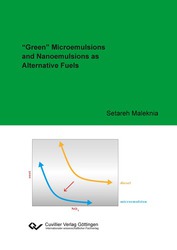| Areas | |
|---|---|
| Serie de libros (96) |
1378
|
| Nachhaltigkeit |
3
|
| Gesundheitswesen |
1
|
| Letra |
2365
|
| Ciencias Naturales |
5406
|
| Matemática | 229 |
| Informática | 319 |
| Física | 980 |
| Química | 1363 |
| Geociencias | 131 |
| Medicina humana | 243 |
| Estomatología | 10 |
| Veterinaria | 108 |
| Farmacia | 147 |
| Biología | 835 |
| Bioquímica, biología molecular, tecnología genética | 121 |
| Biofísica | 25 |
| Nutrición | 45 |
| Agricultura | 1004 |
| Silvicultura | 201 |
| Horticultura | 20 |
| Ecología y conservación de la tierra | 148 |
| Ciencias Ingeniería |
1793
|
| General |
98
|
|
Leitlinien Unfallchirurgie
5. Auflage bestellen |
|
Erweiterte Suche
“Green” Microemulsions and Nanoemulsions as Alternative Fuels (Tienda española)
Setareh Maleknia (Autor)Previo
Indice, PDF (670 KB)
Lectura de prueba, PDF (860 KB)
Combustion of water-containing diesel fuels results in a simultaneous reduction of soot and NOx-emissions, i.e. they partially avoid the so-called soot-NOx trade-off. In the frame of the present work new temperature invariant, highly efficient fuel microemulsions of the type water/antifreeze – diesel fuel – oleic acid/monoethanolamine/oleic acid diethanolamide containing up to 24 wt.% water with appropriate physical characteristics for commercial applications were formulated. As unexpected reward of the investigations on formulation of microemulsion fuels, novel water-in-fuel nanoemulsions (< 200 nm) were obtained featuring substantial reduction of surfactant content, an interesting economical aspect. Exhaust gas emissions, soot-structure and size distribution of water containing fuels compared to pure diesel fuel were analysed. The results show that using load-dependent water containing fuels yield a drastic reduction of soot up to 98 % (FSN) as well as nitrogen oxide emissions up to 62 %.
| ISBN-13 (Impresion) | 9783954049127 |
| ISBN-13 (E-Book) | 9783736949126 |
| Formato | A5 |
| Idioma | Inglés |
| Numero de paginas | 216 |
| Laminacion de la cubierta | Brillante |
| Edicion | 1. |
| Lugar de publicacion | Göttingen |
| Lugar de la disertacion | Köln |
| Fecha de publicacion | 13.01.2015 |
| Clasificacion simple | Tesis doctoral |
| Area |
Físicoquimica
|
| Palabras claves | Microemulsionen, Nanoemulsionen, alternative Kraftstoffe, Schadstoffreduzierung, Biokraftstoff, Ruß-NOx trade off, Tenside, Schmierfähigkeit, DIN 590, Kinetik, Dynamische Lichtstreuung, Additive |








